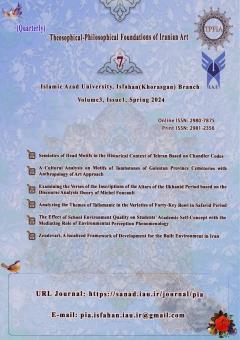Examining the Verses of the Inscriptions of the Altars of the Ilkhanid Period based on the Discourse Analysis theory of Michel Foucault
Subject Areas : Art
Seyed Mahmoud Hosseini Deh Miri
1
![]() ,
Abolfazl Davodi Roknabadi
2
*
,
Shapour Bahyan
3
,
Seyed Rahman Mortazavi Babaheydari
4
,
Abolfazl Davodi Roknabadi
2
*
,
Shapour Bahyan
3
,
Seyed Rahman Mortazavi Babaheydari
4
1 - Ph.D. in Art Research, Lecturer, Farhangian University of Isfahan, Shahid Bahonar Campus, Isfahan, Iran
2 - Professor, Design & Clothing Department, Yazd Branch, Islamic Azad University, Yazd, Iran
3 - Associate Professor and Faculty of Sociology, Mobarake Branch, Islamic Azad University, Isfahan, Iran
4 - Assistant professor, art and architecture faculty, Isfahan (Khorasgan Branch), Islamic Azad University, Isfahan, Iran Tourism, Architecture and Urban Research Center, Isfahan (Khorasgan) Branch, Islamic Azad University, Isfahan, Iran.
Keywords: Altar, Discourse, Ilkhani, Michel Foucault.,
Abstract :
During the Ilkhanid period, after Ghazan Khan converted to Islam, the construction of mosques and paying attention to the decoration of mosques became very important, and it was considered alongside other political efforts to legitimize the Mongols. Establishing legitimacy and popularity among the people does not always happen with the sword and military power and can be achieved with ideological mechanisms. Foucault believes that power influences a network of complex relationships, determines the structure of society, and legitimizes it. He believes that where there is power, there is also resistance. During the Ilkhanid period, Iranian identity was contrasted with Mongolian and non-Iranian identities, and the religion of Islam became important as the main source of legitimizing the identity of the Mongols. As mosque construction continued, paying attention to special altars with specific verses was on the agenda of the government, artists, and founders. The purpose of this research is to examine the discourse of power in the Ilkhanate period and to reveal the motives of the Ilkhan rulers to build special altars with specific verses. This research is in search of an answer to the question: How did the motivations of power among the Ilkhan rulers help to create special altars with specific verses? The research method in this research is descriptive-analytical, and with the philosophical approach of discourse analysis, it examines the verses of the inscriptions on the altars of the Ilkhanid period. The results show that in the construction of patriarchal altars, certain verses with political meanings and themes favored by the patriarchs were involved, and the patriarchs pursued specific political goals through the construction of these altars.
قرآن کریم
آبیار، منصور (1384). بررسی کتیبههای محرابهای سنگی در موزه ملی ایران، مجلۀ اثر، شماره 38، صفحات: 213-235.
ادگار،اندرو، وپیترسچ، ویک (1387). مفاهیم بنیادی نظریۀ فرهنگی، ترجمۀ مهران مهاجر، محمدنبوی، تهران، نشر آگاه.
اشپولر، برتولد (1380). تاریخ مغول در ایران، ترجمۀ محمود میرآفتاب، تهران: انتشارات علمیفرهنگی.
اقبالآشتیانی، عباس (1388). تاریخ مغول از حملۀ چنگیز تا تشکیل دولت تیموری، تهران: انتشارات امیرکبیر.
بختیاریفرد، حمیدرضا (1395). گفتمان ایران شهری در هنر دورۀ ایلخانی، پایان نامه دکتری پژوهش هنر: دانشگاه هنر اصفهان.
برنتس، هانس (1397). مبانی نظری ادبی، چاپ پنجم، تهران: نشر ماهی.
تیلور، استفنی (1399). تحلیل گفتمان چیست، چاپ دوم، ترجمۀ عرفانرجبی، پدرام منیعی، تهران: نشر نویسۀ پارسی.
تقوینژاد، بهاره (1398). «مطالعه تطبیقی تزئینات هندسی محرابهای گچ بری دورۀ سلجوقی با محرابهای گچبری دورۀ ایلخانی در ایران». نشریۀ مرمت و معماری ایران ( مرمت آثار و بافت¬های تاریخی فرهنگی)، دورۀ 9، شماره 20، صفحات: 21-40.
ثقفی، مراد، هنیدس، باری (1390). گفتارهای قدرت از هابز تا فوکو، مترجم، مصطفییوسفی، تهران: نشر پردیسدانش.
حسینی، سیدمحمود، داوودی، ابوالفضل، بهیان، شاپور، مرتضوی، سیدرحمان(1401). «بررسی حضور حکمرانان مغول به هیئت اسکندر در شاهنامۀ بزرگ ایلخانی» نشریۀ بنیانهای حکمی فلسفی هنر ایرانی ، سال اول / شماره اول / پاییز / صفحات 60-75.doi: 10.30486/pia.2022.1967811.1008
رز، ژیلیان( 1398). تحلیل تصویر، ترجمۀ سیدجمال¬الدین اکبرزاده، تهران: انتشارات فرهنگ و هنر و ارتباط.
سودآور، ابوالعلاء (1380). هنر دربارهاي ايران، ترجمۀ ناهيد محمدشميراني، چاپ اول، تهران: انتشارات كارنگ.
شکرپور، شهریار و طاووسی، محمود و قوچانی، عبدالله (1393). «بازتاب رهیافت¬های فرهنگی و اجتماعی عصر ایلخانان بر کاشیهای زرین فام تختسلیمان» نشریه نامه هنرهای تجسمی و کاربردی. دورۀ 6، ش. 11: 53 تا 66. doi: 10.30480/vaa.2013.246
شکفته، عاطفه (1394). مضمون کتیبه¬های قرآنی در محراب¬های گچی عصر ایلخانیان، فصلنامه پژوهش¬های معماری اسلامی، دورۀ 3 شمارۀ 3، پیاپی 8، صفحات:104-120 .
عکاشه، ثروت (1380). هنر اسلامی، ترجمۀ سیدغلامرضاتهامی، تهران: انتشارات حوزه هنری.
عقیلی، سیدوحید، لطفیحقیقت، امیر(1389). «کاربرد روش تحلیل گفتمان در علوم رفتاری» نشریۀ دانشنامۀ واحد علوم و تحقیقات. دورۀ 2، ش.4 : 169تا 194.
فرکلاف، نورمن (1379). تحلیل انتقادی گفتمان، ترجمۀ فاطمهشایستهپیران و ... تهران: مرکز مطالعات و تحقیق رسانه¬ها.
قربانزاده، محمدرضا و همکاران (1386). محرابنامه، تهران: مرکز مطالعات ایلخانشناسی.
کونل، ارنست (1394). تاریخ هنر ایران، هنر اسلامی، ترجمۀ یعقوبآژند، چاپ چهارم، تهران: انتشارات مولی.
گرابر، اولگ (1379). شکل¬گیری هنر اسلامی، ترجمۀ مهرداد وحدتیدانشمند، تهران: پژوهشگاه علوم انسانی و مطالعات فرهنگی.
لین، جورج (1389). ایران در اوایل عهد ایلخانان (رنسانس ایرانی)، ترجمۀ سیدابوالفضلرضوی، تهران: انتشارات امیرکبیر.
مددپور محمد (1383). آشنایی با آرای متفکران در باب هنر، تهران: انتشارات سورۀ مهر.
مورگان، دیوید (1371). مغولها، مترجم عباسمخبر، تهران: مرکز.
ناظری، افسانه، بختیاریفرد، حمیدرضا (1395). «مسئله هویت در عهد ایلخانی مطابق با الگوی کاستلز(مطالعه موردی تحلیل گفتمان خواجه نصیرالدینطوسی) » پژوهشهای علوم تاریخی. دورۀ 8، ش.یک: 115-134. doi:/10.22059/jhss.2017.60652
ووداک، راث، میر، مایکل (1398). روش¬های تحلیل انتقادی گفتمان، ترجمۀ رحیم ایلغمی، تهران: پژوهشگاه عالی دفاع ملی و تحقیقات راهبردی.
ویلبر، دونالد (1365). معماری اسلامی ایران در دورۀ ایلخانان، ترجمۀ عبداللهفریار، تهران: انتشارات علمیوفرهنگی.
هیلن براند، رابرت (1379). معماری اسلامی، فرم، عملکرد و معنی، ترجمۀ ایرج اعتصام، تهران: انتشارات شرکت پردازش و برنامهریزی شهری.

